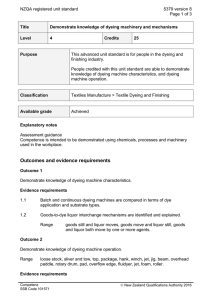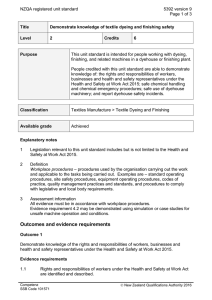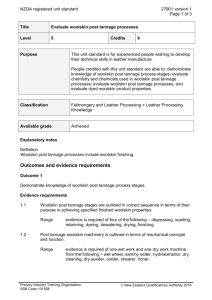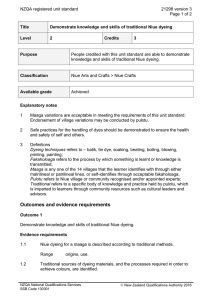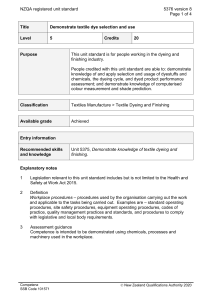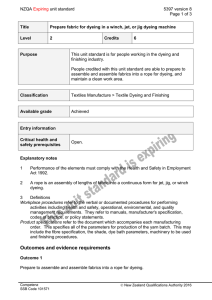NZQA registered unit standard 5377 version 8 Page 1 of 5
advertisement
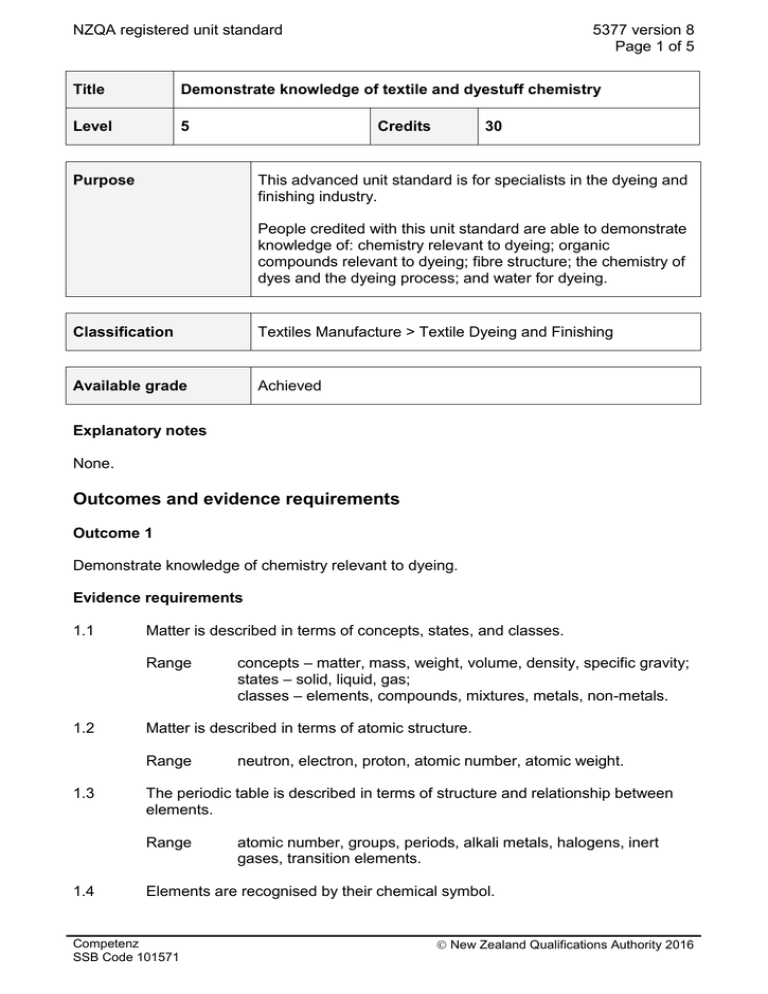
NZQA registered unit standard 5377 version 8 Page 1 of 5 Title Demonstrate knowledge of textile and dyestuff chemistry Level 5 Credits Purpose 30 This advanced unit standard is for specialists in the dyeing and finishing industry. People credited with this unit standard are able to demonstrate knowledge of: chemistry relevant to dyeing; organic compounds relevant to dyeing; fibre structure; the chemistry of dyes and the dyeing process; and water for dyeing. Classification Textiles Manufacture > Textile Dyeing and Finishing Available grade Achieved Explanatory notes None. Outcomes and evidence requirements Outcome 1 Demonstrate knowledge of chemistry relevant to dyeing. Evidence requirements 1.1 Matter is described in terms of concepts, states, and classes. Range 1.2 Matter is described in terms of atomic structure. Range 1.3 neutron, electron, proton, atomic number, atomic weight. The periodic table is described in terms of structure and relationship between elements. Range 1.4 concepts – matter, mass, weight, volume, density, specific gravity; states – solid, liquid, gas; classes – elements, compounds, mixtures, metals, non-metals. atomic number, groups, periods, alkali metals, halogens, inert gases, transition elements. Elements are recognised by their chemical symbol. Competenz SSB Code 101571 New Zealand Qualifications Authority 2016 NZQA registered unit standard Range 5377 version 8 Page 2 of 5 hydrogen, carbon, nitrogen, oxygen, sodium, magnesium, aluminium, silicon, phosphorus, sulphur, chlorine, potassium, calcium, chromium, iron. 1.5 Chemical bonding types are described in terms of ionic, covalent, polar, nonpolar, hydrogen, and Van der Waal types. 1.6 Solutions are described in terms of their characteristics and nature. Range solvents, electrolytes, solvent selectivity, ionisation, dissociation. 1.7 Acids, bases, and salts are compared in terms of their nature, properties, and reactions. 1.8 pH is described in terms of hydrogen and hydroxyl ion concentration, the pH scale, and measurement methods. Range 1.9 measurement methods – chemical indicators, electrical measurement. Chemical equilibrium and buffer solutions are explained in terms of mechanism. Outcome 2 Demonstrate knowledge of organic compounds relevant to dyeing. Evidence requirements 2.1 Compounds of carbon are described in terms of structure, formation, and reactions. Range 2.2 Organic compounds are classified according to functional group and structure. Range 2.3 tetravalency, straight chain molecules, cyclic molecules, homologous series, organic functional groups, saturated and unsaturated hydrocarbons. alcohols, carboxylic acids, esters, soaps, fats and oils, amines, amides. Soaps and detergents are described in terms of their chemical nature and activity. Outcome 3 Demonstrate knowledge of fibre structure. Evidence requirements 3.1 Reactions with chemicals of textile fibres are described in terms of chemical structure. Competenz SSB Code 101571 New Zealand Qualifications Authority 2016 NZQA registered unit standard Range 5377 version 8 Page 3 of 5 cotton, wool, silk, other natural fibres, regenerated cellulosics, polyamide, polyester, polyacrylonitrile, polyolefins. Outcome 4 Demonstrate knowledge of the chemistry of dyes and the dyeing process. Evidence requirements 4.1 Description identifies chemical and radical groupings that determine suitability as a dyestuff. Range 4.2 Dyes are classified according to type and substrate suitability. Range 4.3 type – acid, chrome, metal complex, reactive, direct, sulphur, vat, developed, reactive, disperse, basic, optical brightening agents. Phases of dyeing are described according to dye movement and chemical bonding. Range 4.4 chromophores, chromogens, auxochromes. phases – approach, adsorption, diffusion, migration, fixation. Dyeing is explained in terms of factors that influence the dyeing process. Range dyestuff solubility, pH, dye liquor flow, temperature, affinity, substantivity, concentration, dyeing assistants and auxiliary chemicals. 4.5 Temperature, and temperature measurement and control are described in terms of their effect on the dyeing process. 4.6 pH, and pH measurement and control are described in terms of their effect on the dying process. 4.7 Auxiliaries and dyeing assistants are described in terms of nature, function, and use. Range pre-treatments – bleaching, desizing, metal sequestering, wetting; application of dyestuff – anti-foaming, buffering, de-aeration, dispersion, exhaustion, dye carriers, levelling, fibre protection; after-treatment – fixation, fastness, removal of loose dye, additional properties, change of handle, application of processing aids and silicone application. Outcome 5 Demonstrate knowledge of water for dyeing. Evidence requirements Competenz SSB Code 101571 New Zealand Qualifications Authority 2016 NZQA registered unit standard 5.1 The supply source and chemical composition of different water types are compared. Range 5.2 5377 version 8 Page 4 of 5 rain water, surface water, subsoil water, deep bore water, local body water supply. Textile dyeing and chemical treatments are described in terms of the origin and effect of water contaminants. Range calcium and magnesium, iron, copper, other transition metals, residual chlorine, dissolved oxygen, carbon dioxide, silicon, solids. Planned review date 31 December 2021 Status information and last date for assessment for superseded versions Process Version Date Last Date for Assessment Registration 1 25 October 1995 31 December 2019 Revision 2 8 August 1997 31 December 2019 Revision 3 18 July 2000 31 December 2019 Revision 4 10 October 2001 31 December 2019 Revision 5 15 January 2004 31 December 2019 Rollover 6 25 July 2007 31 December 2019 Review 7 17 April 2009 31 December 2019 Review 8 19 May 2016 N/A Consent and Moderation Requirements (CMR) reference 0030 This CMR can be accessed at http://www.nzqa.govt.nz/framework/search/index.do. Please note Providers must be granted consent to assess against standards (accredited) by NZQA, before they can report credits from assessment against unit standards or deliver courses of study leading to that assessment. Industry Training Organisations must be granted consent to assess against standards by NZQA before they can register credits from assessment against unit standards. Providers and Industry Training Organisations, which have been granted consent and which are assessing against unit standards must engage with the moderation system that applies to those standards. Requirements for consent to assess and an outline of the moderation system that applies to this standard are outlined in the Consent and Moderation Requirements (CMR). The CMR also includes useful information about special requirements for organisations wishing to develop education and training programmes, such as minimum qualifications for tutors and assessors, and special resource requirements. Competenz SSB Code 101571 New Zealand Qualifications Authority 2016 NZQA registered unit standard 5377 version 8 Page 5 of 5 Comments on this unit standard Please contact the Competenz info@Competenz.org.nz if you wish to suggest changes to the content of this unit standard. Competenz SSB Code 101571 New Zealand Qualifications Authority 2016
